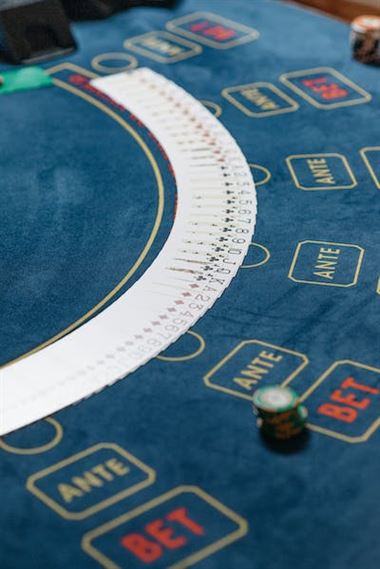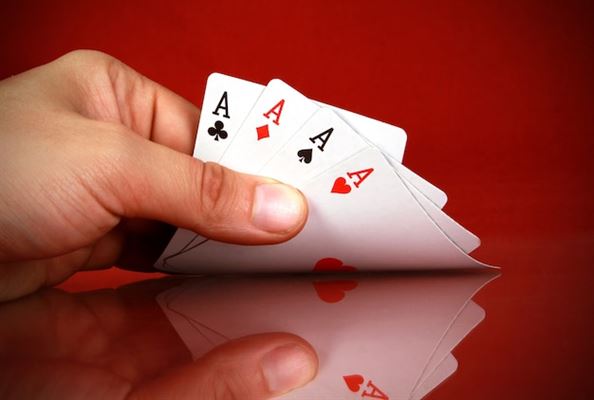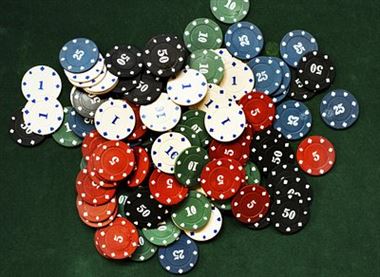“Mind Games at the Table: The Art of Reading Poker Opponents” explores the intricate world of poker and delves into the strategies and techniques used to understand and predict opponents’ moves. This book provides invaluable insights into the psychological aspects of the game, teaching players how to interpret nonverbal cues, analyze betting patterns, and ultimately gain an edge over their adversaries. With a focus on developing a keen sense of observation and intuition, this guide equips poker enthusiasts with the necessary tools to master the art of reading opponents and enhance their overall gameplay.
The Importance of Observing Body Language in Poker Strategy
Poker is a game that requires not only skill in playing the cards but also an ability to read your opponents. While it may seem like a game of chance, there is actually a great deal of strategy involved. One important aspect of this strategy is observing body language.
Body language can provide valuable insights into what your opponents are thinking and feeling. It can give you clues about their confidence level, whether they have a strong hand or a weak one, and even if they are bluffing. By paying close attention to these nonverbal cues, you can gain a significant advantage at the poker table.
One of the first things to look for when observing body language is how relaxed or tense your opponents appear. A player who is sitting back in their chair with a calm demeanor is likely to be confident in their hand. On the other hand, someone who is fidgeting, tapping their fingers, or shifting in their seat may be nervous or unsure of their cards.
Another important clue to watch for is eye contact. Players who avoid making eye contact with others may be trying to hide something or are uncomfortable with their hand. Conversely, those who maintain steady eye contact may be trying to intimidate their opponents or show strength. The eyes can reveal a great deal about a person’s emotions and intentions.
Gestures and movements can also speak volumes in a game of poker. For example, someone who scratches their nose or touches their face may be subconsciously indicating that they are lying or bluffing. Similarly, players who reach for their chips quickly may be eager to bet and are likely holding a strong hand. These subtle actions can provide valuable information if you know what to look for.
Furthermore, pay attention to how your opponents react to certain cards being dealt. If they suddenly become more animated or excited, it could indicate that they have a favorable hand. Conversely, if they appear disappointed or frustrated, it suggests they did not get the cards they were hoping for. These reactions can help you gauge your opponents’ hands and adjust your own strategy accordingly.
While body language is an essential tool in reading poker opponents, it is important to remember that it is not foolproof. Some players are skilled at disguising their emotions and maintaining a poker face, making it difficult to read them accurately. Additionally, cultural differences and personal habits can influence how people express themselves physically.
To become proficient at observing body language in poker, practice is key. Spend time watching other players and noting their behaviors in different situations. Take note of patterns and tendencies that emerge, as these can provide valuable insights into individual playing styles. Over time, you will become more attuned to the subtle signals that can give you an edge in the game.
In conclusion, mastering the art of reading poker opponents through body language is a crucial skill for any serious player. By paying attention to cues such as relaxation or tension, eye contact, gestures, and reactions to cards, you can gain valuable information about your opponents’ hands and intentions. While body language is not always reliable, consistent observation and practice can significantly improve your ability to make informed decisions at the poker table. So next time you sit down to play, remember to keep a keen eye on your opponents – their bodies may be telling you more than their words ever could.
Analyzing Betting Patterns to Predict Opponents’ Hands in Poker
In the high-stakes world of poker, players are constantly looking for ways to gain an edge over their opponents. One of the most effective strategies is the art of reading betting patterns to predict what cards their opponents may be holding. By carefully observing how a player bets throughout a hand, skilled poker players can gather valuable information that can help them make better decisions and increase their chances of winning.
Betting patterns can reveal a lot about a player’s hand strength and overall strategy. For example, if a player consistently makes large bets when they have strong hands and small bets when they have weaker hands, it becomes easier to narrow down the range of possible hands they could be holding. This knowledge allows other players to adjust their own betting accordingly and make more informed decisions.
Furthermore, the timing of a player’s bets can also provide valuable insight into their hand strength. The speed at which a player places their bets can indicate whether they are confident or hesitant about their hand. A quick, confident bet often suggests a strong hand, while a slower, more deliberate bet may indicate uncertainty. Additionally, sudden changes in betting speed can signal a change in the strength of a player’s hand. For instance, if a player has been betting aggressively throughout a hand but suddenly slows down, it could mean they have encountered a less favorable card on the table.
Moreover, the size of a player’s bet relative to the pot can provide clues about their hand strength as well. When a player bets a larger amount than the current pot, it usually indicates confidence in their hand. Conversely, smaller bets may suggest a weaker hand or a desire to keep other players in the hand by offering enticing odds. Skilled players pay close attention to these bet-sizing tendencies and use them to assess the likelihood of their opponents having strong or weak hands.
Additionally, the number of raises or re-raises made by a player can be indicative of their hand strength. Players who frequently raise or re-raise are often holding strong hands, as they are trying to build the pot and force weaker hands to fold. On the other hand, players who rarely raise may have weaker hands or prefer to play more conservatively. Recognizing these patterns allows players to adjust their own betting strategy accordingly and potentially exploit their opponents’ tendencies.
Furthermore, it is essential to consider the overall context of the game when analyzing betting patterns. Factors such as table position, stack sizes, and previous actions can all influence a player’s betting decisions. For example, a player in an early position may be more cautious with their bets, while a player in a late position might be more aggressive. Similarly, players with larger chip stacks may be more inclined to make bigger bets to put pressure on their opponents. By considering these contextual factors alongside betting patterns, skilled players can gain a deeper understanding of their opponents’ strategies and make more accurate predictions about their hands.
In conclusion, analyzing betting patterns is a crucial skill for any serious poker player. By carefully observing how opponents bet throughout a hand, players can gather valuable information that can help them make better decisions and increase their chances of winning. The size, timing, and frequency of bets can all provide clues about a player’s hand strength and overall strategy. Additionally, considering the overall context of the game can further enhance a player’s ability to accurately predict their opponents’ hands. Ultimately, mastering the art of reading betting patterns is an essential tool in the arsenal of any successful poker player.
Mastering Bluffing Techniques for Poker Success
Poker is a game of skill and strategy, where players must make calculated decisions based on the information available to them. One crucial aspect of poker that separates the amateurs from the professionals is the ability to read opponents and decipher their intentions. Mastering bluffing techniques is essential for any serious poker player looking to achieve success at the table.
Bluffing is a fundamental part of poker, allowing players to deceive their opponents into making incorrect decisions. It involves representing a stronger hand than what one actually holds, forcing opponents to fold their hands and relinquish their chips. However, successful bluffing requires more than just luck or intuition; it requires careful observation and analysis of opponents’ behavior.
The first step in mastering bluffing techniques is understanding the importance of observing opponents closely. By paying attention to their actions, facial expressions, and body language, you can gather valuable information about their hand strength and potential strategies. For example, if an opponent suddenly becomes more animated or starts fidgeting nervously, it could be a sign of weakness or uncertainty.
In addition to visual cues, verbal clues can also provide insight into opponents’ thought processes. Pay close attention to the words they use and how they say them. If an opponent seems overly confident or tries to convince others of their strong hand, it could indicate a bluff.
Another important aspect of reading opponents is recognizing patterns in their betting behavior. Keep track of how much they bet in different situations and whether there are any consistent patterns. Some players may consistently raise when they have a strong hand, while others might become more cautious or even check when they’re bluffing.
Furthermore, timing is crucial when it comes to bluffing successfully. Learning to recognize opportune moments to bluff can greatly enhance your chances of success. For instance, bluffing when there are fewer players left in the hand or when the community cards don’t favor any specific hand can increase the likelihood of opponents folding.
However, it’s important to note that bluffing should be used strategically and sparingly. Overusing this technique can lead to predictability and make your bluffs less effective. Instead, vary your play style and mix in occasional bluffs with strong hands to keep opponents guessing.
Lastly, adapting to different opponents is essential for successful bluffing. Each player has their own unique style and tendencies, which you must learn to exploit. Some opponents may be more risk-averse and fold easily, while others might be more aggressive and difficult to bluff.
In conclusion, mastering bluffing techniques is a crucial skill for poker success. By carefully observing opponents’ behavior, recognizing patterns, and understanding timing, you can improve your ability to read opponents and execute successful bluffs. Remember to use bluffing strategically and adapt your approach based on the individual players at the table. With practice and experience, you can become a formidable opponent who consistently outwits and outplays others at the poker table.
Understanding Psychological Tactics in Poker Mind Games
Poker is not just a game of cards; it is a battle of wits, where players strategically try to outmaneuver their opponents. While mastering the rules and strategies is crucial, one aspect that often separates the winners from the losers is the ability to read their opponents’ minds. This skill, known as “reading poker opponents,” involves understanding the psychological tactics used by players to gain an advantage.
One of the key elements in reading poker opponents is observing their body language. A player’s physical movements and facial expressions can reveal vital information about their hand strength or intentions. For example, a player who nervously taps their fingers on the table may be bluffing, trying to appear confident while hiding a weak hand. Conversely, someone who avoids eye contact and fidgets in their seat might have a strong hand but is anxious about revealing it. These subtle cues provide valuable insights into the opponent’s mindset and can help shape your own strategy accordingly.
Another important factor in reading poker opponents is studying their betting patterns. How much they bet, when they bet, and how they react to others’ bets can all reveal valuable information. A player who consistently raises before the flop might be playing aggressively, indicating a strong hand. On the other hand, someone who frequently checks or calls might be more passive and likely holding a weaker hand. By paying attention to these patterns, you can adjust your own betting strategy to exploit your opponents’ weaknesses and maximize your chances of success.
Furthermore, understanding the concept of “tells” is essential for reading poker opponents. Tells are unconscious actions or behaviors that inadvertently give away a player’s thoughts or intentions. Some common tells include rapid breathing, sweaty palms, or even changes in vocal tone. However, it is important to note that not all tells are reliable indicators, as experienced players can intentionally use false tells to deceive their opponents. Therefore, it is crucial to combine tell analysis with other strategies to form a more accurate assessment of your opponents’ hands.
In addition to these physical and behavioral cues, the ability to analyze your opponents’ thought processes is vital in reading poker opponents effectively. By considering factors such as their playing style, previous actions, and overall strategy, you can gain insights into how they think and make decisions at the table. For instance, a player who consistently plays conservatively may be risk-averse and only bet when they have a strong hand. Conversely, an aggressive player might bluff frequently but also take calculated risks. Understanding these thinking patterns allows you to anticipate your opponents’ moves and adjust your own tactics accordingly.
However, while reading poker opponents can provide valuable information, it is important not to solely rely on this skill. Poker is a complex game that requires a combination of strategies, mathematical calculations, and intuition. Reading opponents should be seen as just one tool in your arsenal, rather than the sole determinant of your success.
In conclusion, mastering the art of reading poker opponents is an essential skill for any serious player. By observing body language, analyzing betting patterns, deciphering tells, and understanding thought processes, you can gain a significant advantage at the table. However, it is crucial to remember that reading opponents is not foolproof and should be used in conjunction with other strategies. Ultimately, the key to success lies in a well-rounded approach that combines psychological tactics with solid gameplay.
Using Probabilities and Odds to Outsmart Your Poker Opponents
Poker is a game of strategy and skill, where players must not only rely on the cards they are dealt but also on their ability to read their opponents. The art of reading poker opponents involves analyzing their behavior, body language, and betting patterns to gain insight into the strength of their hand. While it may seem like an impossible task, there are ways to increase your chances of success.
One effective strategy in reading poker opponents is using probabilities and odds to your advantage. Understanding the likelihood of certain hands appearing can help you make informed decisions and outsmart your opponents. By calculating the odds of specific card combinations, you can determine the probability of your opponent having a strong hand.
To start, familiarize yourself with the basics of poker probabilities. Knowing the odds of being dealt certain hands, such as a flush or a straight, can give you a better understanding of what your opponent might be holding. For example, if you have two hearts in your hand and there are two more on the table, the odds of completing a flush are relatively high. If your opponent suddenly starts betting aggressively, it could indicate that they have a strong hand, possibly a flush themselves.
In addition to considering the overall odds of certain hands, pay attention to the specific community cards on the table. This will help you narrow down the range of possible hands your opponent might have. For instance, if the flop consists of three low-value cards, it’s less likely that your opponent has a strong hand. On the other hand, if the flop contains high-value cards, such as a king and queen, there’s a higher chance that your opponent has connected with those cards.
Betting patterns can also provide valuable information about your opponents’ hands. Pay close attention to how they bet throughout the game. Do they tend to bet aggressively when they have a strong hand? Or do they play more conservatively? If your opponent suddenly increases their bets after a certain card is revealed, it could indicate that they have a favorable hand. Conversely, if they suddenly become more cautious, they may be bluffing or trying to hide the weakness of their hand.
While probabilities and odds can be helpful tools in reading poker opponents, it’s important not to rely solely on them. Every player has their own unique style and strategy, so it’s crucial to observe and adapt accordingly. Look for inconsistencies in your opponent’s behavior and try to identify any patterns they may have. Are they easily rattled when faced with a large bet? Do they tend to fold quickly if they don’t have a strong hand? These observations can give you valuable insights into their playing style and help you make better decisions at the table.
In conclusion, using probabilities and odds to outsmart your poker opponents is an essential skill for any serious player. By understanding the likelihood of certain hands appearing and analyzing your opponent’s behavior and betting patterns, you can gain a significant advantage. Remember, though, that no strategy is foolproof, and adapting to the ever-changing dynamics of the game is key. So sharpen your skills, trust your instincts, and enjoy the mind games that come with playing poker.




